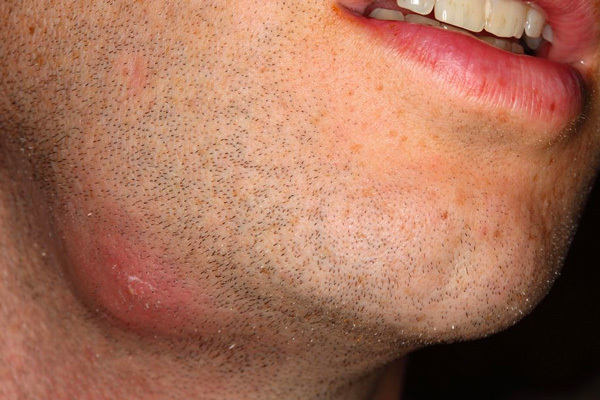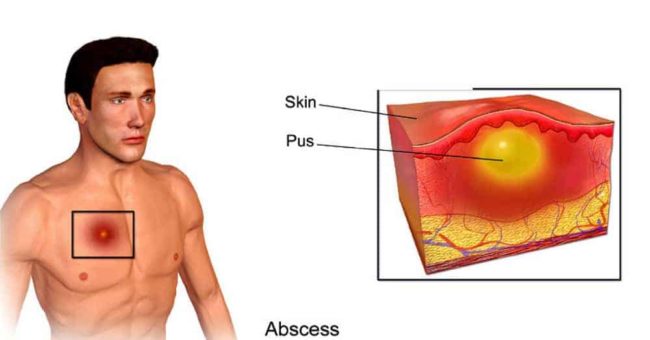How long does it take for an abscess to heal is people’s biggest concern after having an abscess lanced and drained.
The time it takes for an abscess to heal depends on how big it is and how fast you heal.
Sometimes it takes only a couple of days, sometimes it takes weeks. But first, let’s actually get to know all there is to an abscess so you can grasp a better understanding of it.
What is an Abscess?

An abscess is an area below the outer layer of skin where pus (infected fluid) collects and forms a pocket of infected fluid with a thick wall around it.
Most of the time, an abscess is caused by bacteria, fungi or other germs that get into an open existing wound.
How Does it Occur?
When bacteria enter a break in the skin/wound, an abscess appears. For instance, an abscess might develop when a hair becomes ingrown or when the skin is scraped or hurt with something sharp.
Naturally, the body responds to bacteria multiplying inside the skin by building a wall around the area to prevent the bacteria from spreading to other parts of the body.
The pocket will turn more swollen as the bacteria in it continue to grow. Even worse, some of the bacteria may break through the wall and cause an infection on other tissues around the abscess area or flow into the bloodstream and contaminate other body’s parts.
Normally abscesses occur when hair follicles or sweat glands get infected or after minor scratches or puncture injuries.
What are The Symptoms?
If the skin around the abscess has become infected, the redness may spread toward the center of the body and you may have a fever, body aches, and tiredness. The symptoms should be as follows:
- Swelling
- Redness
- Rounded, raised “head” like a pimple
- Pain
- Warmth in the area of the abscess
- Drainage of pus or other fluid.
How is an Abscess Treatment at Home?
You can’t really tell if it really is an abscess so you need your health care provider to examine the wound area. A sample of pus from your abscess should indicate what is the reason behinds your infection.
A procedure called Incision and Drainage, or I&D is used to remove pus and fluid from the abscess. Your healthcare provider will make a cut in the abscess so it can drain.
To help prevent the spread of the infection to other parts of the body, your medical personnel, as part of the treatment, will prescribe antibiotics.
The thick wall around an abscess will not let antibiotics go through to fight the infection in it; therefore; the abscess itself needs to be cut open and drained out so that antibiotics could actually take effect.
Gauze will be put into the wound to pack the pocket, it will be covered with a bandage (you should keep track of how many pieces of gauze are placed inside the wound).
One end of the gauze is in the abscess and the other end is left sticking out through the cut in the skin.
This allows the pus that builds in the abscess to drain out. The gauze packing needs to be changed every day or two.
Your body will fill in the pocket where the abscess was with new tissue. Once the abscess is filled up, the packing will be taken out for the last time allowing the skin to shut and heal.
Do not put too much packing in the wound and do not pack the gauze too tightly in your wound, otherwise, it could badly affect your recovery.
Sometimes, surgery could be needed to remove your abscess. Your doctor may do this if the abscess is on your hands or buttocks.
Surgery can lower the risk of an abscess coming back. Remember that you should not open or squeeze out an abscess by yourself. This can make the infection much worse.
How Long Does it Take for an Abscess to Heal?
An abscess should take a few days to heal completely. The doctor should ask you to return to have the packing removed the next day or two–or if it’s small, he may suggest that you remove the packing yourself and the “hole” will eventually close up.
The wound is healed from inside out–if it’s closed (sutured back or taped back into place) the moment after it’s lanced, space will most likely be filled back up, and it will have to be popped open again.
The healing process depends on how long it takes for all the rubbish to come out and how deep the abscess is. If the root of the abscess is left, it will continue to fester.
Make sure that you take the antibiotics as prescribed and do as the doctor advised you. Take pain relief medication as prescribed on the packet to help lessen the pain also.
It probably will remain swollen for several days, but everyone is different, so no one can say for sure how long the healing process will be.
What Can You Do to Take Care of Your Wound?
As we can’t tell how long does it takes for an abscess to heal fully for sure, here are some good pieces of advice to make the recovery faster.
Follow your doctor’s instructions for treating the wound at home. If he allows it, remove the bandage and gauze packing carefully. Clean your wound and the area around it as instructed. Dry the area and put on new, clean bandages. Change your bandages when they get wet or dirty.
If the gauze pops out before it is supposed to, you may need to visit your doctor to have it fixed so the skin does not close too soon. If your doctor prescribes antibiotics, take them exactly as you are directed.
Put a warm gauze on your abscess. This will keep it open and drain. Apply the warm gauze (not too hot) for 10 minutes. Repeat this 4 times a day.
Try not to press on an abscess or open it with a needle for you might push the bacteria deeper into your blood and worsen the infection.
Wash your hands often to help prevent the spread of germs. Use soap and water or an alcohol-based hand rub. You need your hands clean when taking care of the abscess at home.

